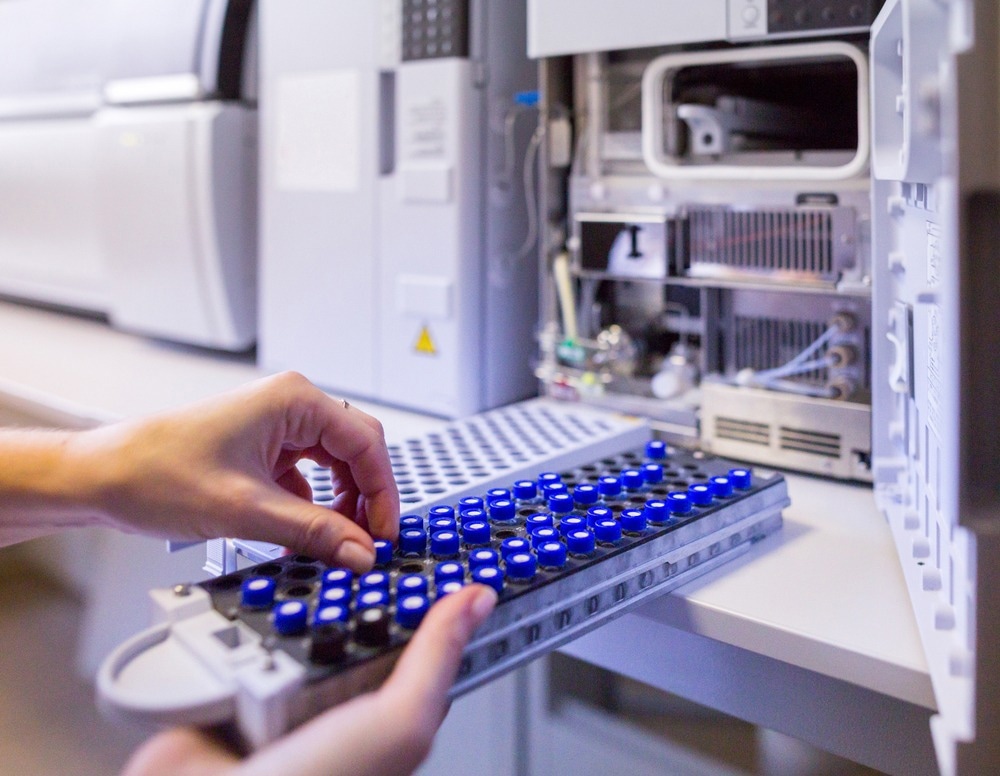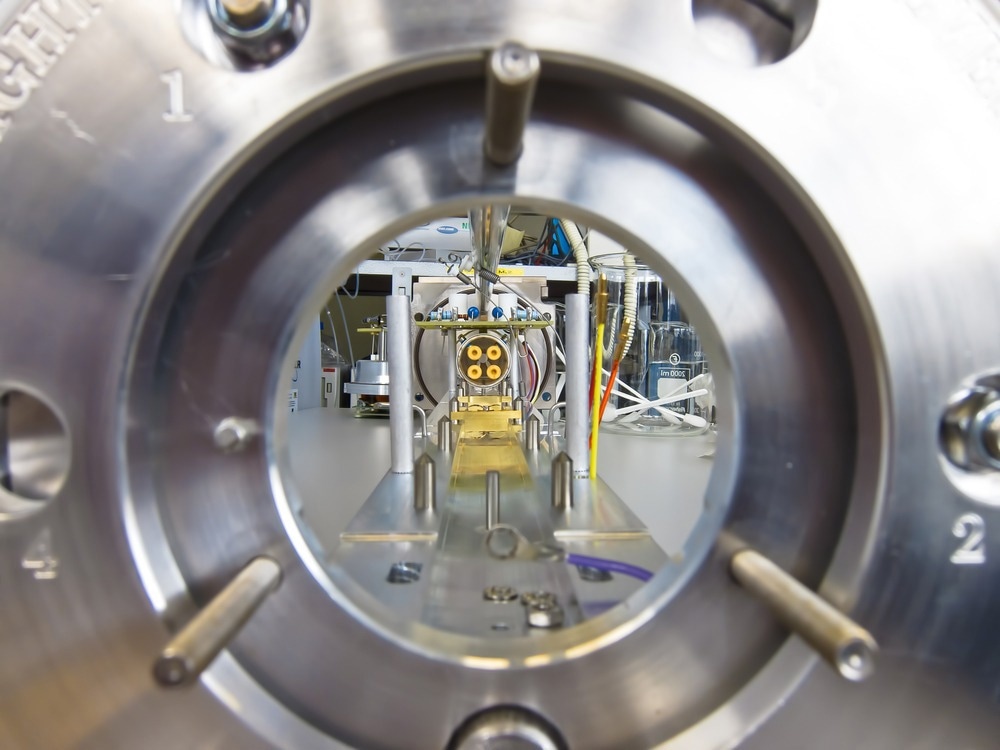Spectrometer accessories are an excellent way of enhancing the function or performance of a spectrometer. Some common accessories of choice introduce functionality such as temperature control of the sample or allow for automated sampling.1

Image Credit: Sodel Vladyslav/Shutterstock.com
Enhancing Spectral Resolution and Accuracy
When designing or purchasing a spectrometer, some key considerations include the required spectral range, limit of detection and necessary resolution.2 If the instrument is to be share and used for several applications, it can be challenging to achieve a specification that matches all users’ needs without compromise.
For example, in dispersive spectrometers, achieving a higher spectral resolution usually means a reduction in the wavelength range that can be detected.3 Many gratings also do not have flat transmission curves, so will have a higher throughput over a particular wavelength range, meaning the spectrometer may show poor efficiency in certain spectral regions.
Spectrometer accessories can help circumvent the problem of design compromises. Many commercial spectrometers, UV-vis spectrometers in particular, come with spectrometer accessories such as ‘grating turrets’ so that the optimal grating can be switched in even in an automated fashion.
A number of spectrometers come with spectrometer accessories, such as mechanical variable exit slits. As the exit slit size is an important parameter in determining the overall resolution of a spectrometer, being able to vary the slit size is an excellent way of balancing light throughput with resolution for applications where a large range of sample concentrations may be measured.
The accuracy of a spectrometer is how close the measured value is to the ‘true’ value – which is normally assessed by the measurement of calibration or reference samples.
Spectrometer accessories like variable slits are important in improving the accuracy of measurements as most spectrometers have a limited range of linear detection – so improving the light throughput can help keep measurements in this range.
Expanding the Range of Detectable Materials
If a spectrometer is to be used for high throughput measurements, the convenience of sample loading becomes an important factor. If a very wide range of sample concentrations is to be used in absorption/transmission spectroscopy, it can be worthwhile to consider spectrometer accessories such as variable path length sample holders or instruments.4 As the signal intensity is proportional to the product of the concentration and path length, increasing the path length is one way of concentrating for weak samples.
Other spectrometer examples are sample cells optimized for measuring particular states of matter, i.e. gases, liquids or solids. Spectrometer accessories for liquid samples may vary from simple quartz or plastic cuvettes to more specialist airtight designs for handling air-sensitive samples.

Image Credit: Jens Goepfert/Shutterstock.com
Adapting to Varied Environmental and Experimental Conditions
In operando measurements have become increasingly popular in battery research and catalysis as a way of trying to monitor device performance under realistic conditions. Now, there is a variety of in operando spectrometer accessories developed in-house by research groups as well as commercial options that facilitate applying a variety of conditions during measurements.5
Another commonly controlled environmental condition is temperature settings. Cryostats are a popular spectrometer accessory for making very high-resolution measurements, as cooling samples can help narrow line widths by ensuring the population of the vibrational modes is exclusively in the ground states.
Varying and controlling temperatures can be a valuable way of performing measurements to understand reaction mechanisms and provide experimental data for calculating reaction barriers.6 Well-controlled temperature conditions are also essential for ensuring good reproducibility between measurements.
Facilitating Sample Introduction and Handling
High-throughput and automated measurements are becoming increasingly popular with several spectroscopic techniques, partly facilitated by the development of automated data analysis methods that can provide insight into complex datasets without manual intervention.
Spectrometer accessories that facilitate the automated changing of cuvettes or sample holders are essential to automation and improving laboratory efficiency. Most typical UV-vis or infrared spectrometers only have space for a single sample cell within the instrument, and so many of the spectrometer accessories for autosampling instead make use of flow cells, where a carousel of samples is held external to the instrument and then injected in when required.
For thin-film samples where the angle at which the sample is placed relative to the incident beam will affect the measurement, there are also spectrometer accessories designed for the automatic rotation and positioning of samples. This can be used for anisotropy measurements or to help minimize the effects of scatter in such measurements.
Enabling Advanced Data Analysis and Interpretation
The spectrometer control and data analysis software can be as important as a spectrometer accessory as any hardware. Advanced automation also requires the ability to program advanced automated experimental protocols. There may also be the need to set up feedback systems to alert operators if measurements need to be redone or if there is an issue with the instrumentation.
Spectrometer accessories for data interpretation may include automated magnification for imaging applications, automated parameter calculation from variable temperature experiments, or automatically varying path lengths to improve data quality.
Sources:
- Bruno, T. J. (1999). Sampling accessories for infrared spectrometry. Applied Spectroscopy Reviews, 34(1–2), pp. 91–120. doi.org/10.1081/ASR-100100840
- Scheeline, A. (2017). How to Design a Spectrometer. Applied Spectroscopy, 71(10), pp. 2237–2252. doi.org/10.1177/0003702817720468
- Polder, G., et al. (2003). Calibration and characterisation of imaging spectrographs. Journal of Near Infrared Spectroscopy, 11(3), pp. 193-210. doi.org/10.1255/jnirs.366
- Cozzolino, D. (2015). Sample presentation, sources of error and future perspectives on the application of vibrational spectroscopy in the wine industry. Journal of the Science of Food and Agriculture, 95(5), pp. 861–868. doi.org/10.1002/jsfa.6733
- Srinivasan, P. D., et al. (2018). Modified Harrick reaction cell for in situ/operando fiber optics diffuse reflectance UV–visible spectroscopic characterization of catalysts. Applied Catalysis A: General, 561(February), pp. 7–18. doi.org/10.1016/j.apcata.2018.05.009
- Cerdà, V., González, A., & Danchana, K. (2017). From thermometric to spectrophotometric kinetic-catalytic methods of analysis. A review. Talanta, 167(January), pp. 733–746. doi.org/10.1016/j.talanta.2017.02.004
Last Updated: Feb 15, 2024